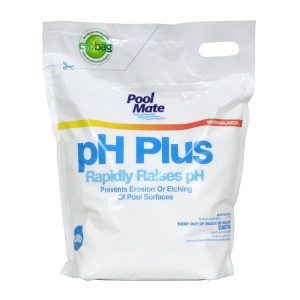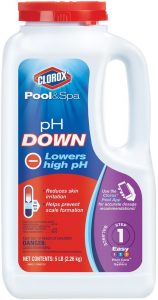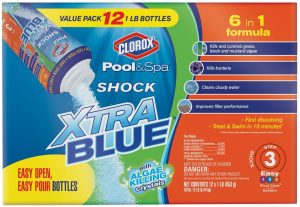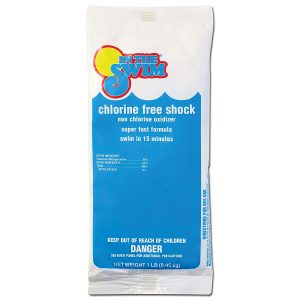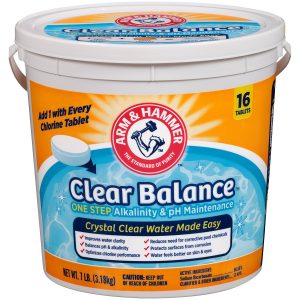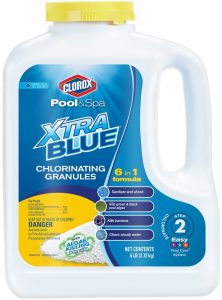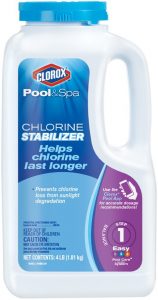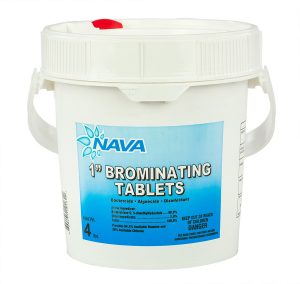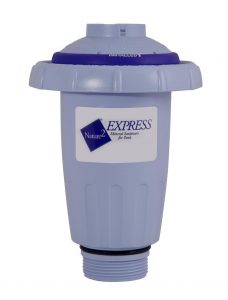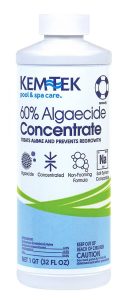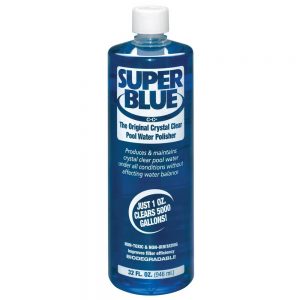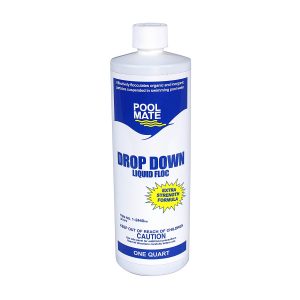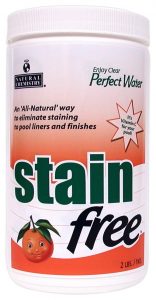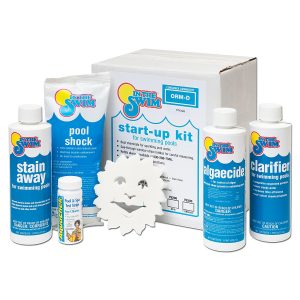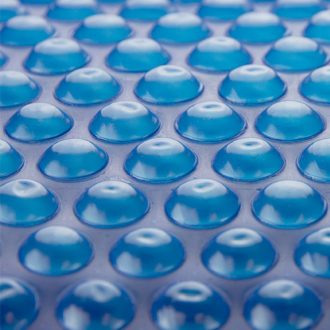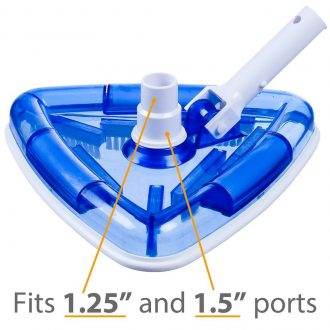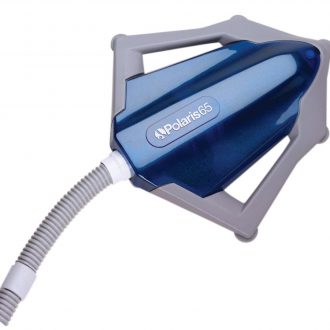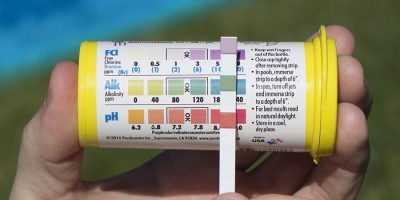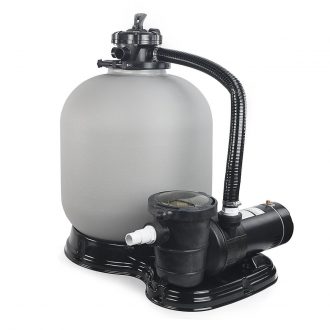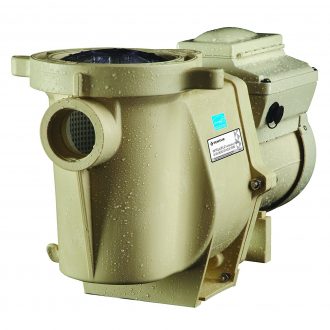A lot of new pool owners don’t realize how important it is to maintain a clean pool, and it isn’t exactly easy to know where to start. The right amount of chemicals and daily to weekly maintenance can turn your green or cloudy pool water clear and safe for swimming.
We have now written an article specifically focused on pool water test strips and test kits.
Pool Chemicals 2020: Balance, Shocks, Chlorine/Bromine and more…
Before adding any chemicals, it’s a good idea to start out by checking your pool’s water balance.
Water Balance: pH+, pH- & Alkalinity
Even though many might not think about it at first, maintaining your pool’s water chemistry is essential in keeping the water clean and bacteria-free. The things to look out for is your pH and alkalinity levels on a daily basis until you’ve gained enough knowledge on how your pool works.
To keep your pool water balanced you’ll need a pH increaser, a pH reducer, and an alkalinity increaser. If your pool is balanced, it’ll make sanitizers work much more effectively.
You can use test strips for a quick way to test your pool water.
Increasing pH
A pH increaser increases your pool’s pH (or acidity) level if it’s below 7.2 (acid). This Pool Mate pH Plus increaser has sodium bicarbonate (or baking soda) as an active ingredient to reduce irritation to the eyes caused by acidic water, raises pH levels, and slows down the rapid disintegration of chlorine.
It also helps to reduce the corrosion of any pool equipment and etching of plaster pool walls. It comes in a granular form so that it’s easy to use and the usual dosage for this pH increaser is 1 pound per 10,000 gallons.
Reducing pH
A pH reducer is used in hard water areas if chlorine is used and should be added to reduce your pH balance if it’s found to be above 7.6 (alkaline). This Clorox Pool & Spa pH Down reducer lowers pH levels to protect your pool equipment and pool surfaces. It’s safe to use in hot tubs or swimming pools, and it also works to optimize sanitizer efficiency and lowers the risk of skin irritation and red eyes.
Increasing Alkalinity
For soft water areas, alkalinity increaser is added directly to stabilize the pH and needs to be agitated to dissolve. The recommended alkalinity level is 100 to 150 ppm (parts per million).
This Pool Mate Total Alkalinity Increaser raises the total alkalinity levels in your pool water to reverse the effects of corrosive water which can damage the pool’s surfaces and equipment. It boosts the effectiveness of pool sanitizers and disinfectants as well as preventing the formation of scales, metal corrosion, and etching.
After checking and making adjustments to your water balance, you can continue with using a pool chemical that will help keep your water clean and free from bacteria and algae. Some chemicals have different forms and work a bit differently, but they all ultimately work to prevent your pool from turning cloudy and unfit for swimming.
Pool Shocks + How to Shock
Pool shocks unbind or oxidize the organic contaminants such as bacteria in your water, which ultimately destroys them. It’s basically like “super-chlorinating” the pool to break up any impurities that have built up over time. Pool shocks are usually used around the beginning of the pool season or after heavy usage since shock chemicals are incredibly powerful oxidizers, which are good for when you need extra bacteria-killing power.
Chlorine and Chlorine-Free Pool Shock
Pool shock chemicals come in different types such as chlorine pool shock and chlorine-free pool shock. You should use pool shock about once every 1 to 2 weeks depending on how much you use your pool. If you ever accidentally put too much chlorine in the water but aren’t shocking it, thiosulfate can help to neutralize some of the chlorine.
This Clorox Pool & Spa Xtra Blue Pool Shock comes in easy to open and pour bottles which contain blue crystals that work to kill and control green, black and mustard algae and bacteria. It clears up cloudy water and improves your filter’s performance with its fast dissolving 6-in-1 formula.
If you’d like something chlorine-free, this In The Swim Chlorine-Free Pool Shock contains 38% potassium monopersulfate and is ideal for bromine sanitized pools. Its powerful oxidizing agent effectively burns off dead chlorine cells to give your water a higher free chlorine level, and since its fast formula dissolves quickly, your pool can be ready for swimming in no time.
How to Shock your Pool
To shock your pool, first make sure that you have:
- A big bucket
- Pool shock
- A pair of rubber gloves
- Protective eyewear
- A stirring stick
Next, fill the bucket with water and then add 1 pound of shock to it. Be careful not to splash any pool shock on your clothes since it has a high concentration of chlorine in it and it can bleach your clothes.
After stirring, make sure your pool filter and pump is running before going around the pool and pouring the shock. It’s ideal to do this at night or dusk and let your pool run overnight since sunlight can rapidly dissolve shock and it won’t be able to do its job. Always predissolve your shock, which means add the shock to water, not the other way around. 1 bag of shock per 10,000 gallons of water is the appropriate ratio.
Pool Sanitizers
Pool sanitizers help prevent the growth of algae and bacteria, and while there are several different types available like liquid, granules, tablets, and sticks, chlorine tablets are the most common. They range from 1-inch to 3-inches in size and can be inserted into a floating chlorine dispenser (to keep them away from kids), a chlorinator, or a skimmer basket. They’re also better for hard water areas since they reduce the pH level and alkalinity.
A popular choice for chlorine tablets are the Arm & Hammer Clear Balance Pool Maintenance Tablets, which maintain your pool’s pH balance and alkalinity while improving chlorine performance. It’s a convenient way to clear up cloudy water, maintain clarity, and prevent corrosion and staining to masonry and synthetic pool surfaces.
Chlorine granules are more suitable for soft water areas since they don’t reduce the pool’s pH balance or alkalinity. Clorox’s Pool & Spa Xtra Blue Chlorinating Granules serves as an all-purpose sanitizer, shock, and algaecide with its nifty 6-in-1 formula. It helps to improve your pool’s water quality without dissolving rapidly under the sun’s rays and can be used for daily use through a skimmer or directly to water.
Pool Stabilizers
Something to keep in mind is that pool shocks are either made with unstabilized chlorine or no chlorine whatsoever. After they do their job, they can get dissolved by the sun’s rays rather quickly. Because of this, it’s recommended that you shock your pool at night or when the sun is going down to let it work overnight for at least 8 hours.
To make chlorine last longer, you can use stabilizers like Clorox’s Pool & Spa Chlorine Stabilizer. It provides protection for chlorine molecules so they won’t be quickly dissolved from the sun’s rays, which extends the chlorine’s use and saves money.
Bromine, or “Chlorine’s Cousin”
Bromine, also known as chlorine’s halogen cousin, is another option for keeping your pool clean without worrying about that strong “pool smell” or irritant side effects you can get like red eyes and itchy skin. Usually used in hot tubs or indoor pools, it’s sold in either 1-inch tablets or in granular form.
Bromine works a bit differently than chlorine and it’s not as effective when dealing with certain types of algae. Because bromine is unstabilized, it’s not recommended for outdoor pools in the sunlight since it can be eaten up rapidly. If you must use it in an outdoor pool, be sure to use it at night or dawn.
These Nava 1-Inch Swimming Pool and Spa Bromine tablets are an ideal chemical sanitation treatment for use in both spas and pools. Its germ and algae killing abilities are less dependent on pH compared to chlorine and there’s no stabilizer build up. You can insert these tablets in a floating dispenser or automatic brominator for cleaner and clearer water without the side effects of skin irritation, rough hair, or red eyes.
Other Sanitation Alternatives
There are also other options for green or alternative sanitation which include natural and enzyme-based chemicals.
For example, biguanide is a chlorine-free and effective sanitizer that can make the water feel smoother. This Baquacil Sanitizer sanitizes your pool water and prevents algae from growing with its chlorine-free formula. Its active ingredient is Poly (hexamethylene biguanide) hydrochloride, which is a practical alternative for those who don’t wish to use chlorine or other potentially irritant chemicals.
You can additionally sanitize your pool using a mineral system which introduces silver and copper minerals into the water. These minerals do sanitize your pool but it works a lot slower than chlorine. It’s not meant to be a compete chlorine alternative since chlorine is still required but it does reduce chlorine use by up to 50%.
There are options such as the Nature2 Express Mineral Cartridge Sanitizer which is ideal for above-ground pools or in-ground pools up to 25,000 gallons. It helps to destroy bacteria and control algae while reducing the amount of chlorine needed which can cause stinging eyes and irritated skin.
Algaecides + Types of Algae
Algaecides are great for preventing your pool from growing annoying and unattractive algae bunches. Algae is a form of plant life that usually grows by ammonia in the water that’s turned into nitrate which is food for algae. It can make pool water cloudy and green, while also clogging up filtration systems. The best killer of algae is actually chlorine, but algaecide can be used as a backup to keep the algae tamed if your chlorine levels are low.
You can check out this Kem-Tek Pool and Spa 60% Concentrated Algaecide that’s safe with all pool and filter types. It has a non-foaming formula and is compatible with salt water systems, lasting a long time to prevent further algae growth.
Types of Algae in the Pool
Green algae is the most common and the easiest type of algae to get rid of since you can just brush it off and kill it with algaecide, but yellow or mustard algae can be stubborn and grows on pool walls that don’t get too much sun. It’s the second most common algae you’ll find in a pool, and can be mistaken for pollen or sand.
Unfortunately, a dose of algaecide or pool sanitizer won’t do much to get rid of yellow algae, so you’ll need to shock your pool with a high dosage or else the algae will keep coming back throughout the summer season.
Black algae is the most difficult to get rid of, but thankfully it’s not very common. Its defense mechanism and strong roots make it hard to simply brush off, so just like yellow algae, you’ll need a high dosage of pool shock and a heavy-duty brush to get rid of it.
Remember that algae is most likely to grow due to lack of sanitation and when the water in the pool isn’t circulating. It’s important to keep water moving with a pump and filter so it’s more difficult for algae to grow. Make sure to also check in dark places of your pool since algae loves to thrive in them. Under the ladder steps, on the pool steps, and your pool’s corners and creases is where you can often find algae growth.
Clarifier
A water clarifier simply takes all the tiny particles that make your water cloudy and make them into bigger particles that settle to the bottom of the pool that your pool filter will have an easier time picking up. This Robarb Super Blue Clarifier is made of a concentrated formula where 1 ounce can treat up to 5,000 gallons of water. It reduces the amount of sanitizer needed by removing dirt particles and clears cloudy water while further preventing any future hazy appearances in your pool.
Pool Floc
Floc, or also called flocculant, works similarly to clarifiers as they grab tiny particles, combine them together, and then bring them to the bottom of the pool. Although, with pool floc, you have to manually remove the particles from the water by pool vacuuming. This Pool Mate Drop Down Liquid Floc effectively flocculates particles that are suspended in your pool water and makes them sink to the floor after binding them together for an easy vacuuming job.
How to Floc Your Pool
To floc your pool, if you have a multi-port valve on your filter:
Turn off your pump and set the valve to “recycle” or “recirculate.” This’ll prevent the water from flowing through the filter and will help mix the chemical in as the water is spinning.
Add the recommended portion of floc for the size of your pool. There are usually directions or charts on the floc package that show the right dosage you need.
Afterwards, you want to let the water circulate for at least 2 hours so that the floc can be thoroughly mixed in, then you can shut off your pump and have the water sit overnight. In the morning, there should be a particle cloud settled at the bottom of the pool.
Hook up a manual vacuum cleaner and be sure you have your multi-port valve set to “waste” before turning your filter on, or else the cloudy water will just go back into your pool through the return lines. Have your backwash hose connected to the backwash/waste port and lead the hose where you want the dirty water to end up. You can turn your garden hose on to replace the water with clean water as you vacuum out the cloudy water to save time.
Take your time to slowly vacuum the bottom of the pool because as you maneuver the vacuum across the floor, it’ll start to kick up debris. If it gets too cloudy to the point where you can’t see your vacuum, you can turn off your pump and let it sit until the dirty water resettles before going back to vacuuming again.
This may take several attempts depending on how much cloudy water needs to be removed and how big your pool is. You have the option of double shocking your pool after you’re done vacuuming to ensure that all algae and bacteria has been removed.
Stain Removal and Prevention
A common issue that a lot of pool owners deal with is stains and water lines, so pool stain removers and stain prevention chemicals help to remove and fight back stains that are caused by metals like copper, lead, silver, and nickel. These metals are the main cause behind discoloration and scaling in pool water, so by using these chemicals on a regular basis, manual scrubbing and cleaning are reduced and it’ll be much easier to maintain a clean and clear pool.
A fairly popular option is the Natural Chemistry Pool Stain Remover. Its ascorbic acid formula is ideal for treating stain on vinyl liner and fiberglass pool surfaces and doesn’t create any residual phosphates in the water.
Chemical Kits
In addition to using the mentioned pool chemicals weekly, you can also use pool chemical kits which have everything you need for a successful winterizing or pool opening and closing. They’re easier to use since you don’t have to do any guess work and have pre-measured chemicals based on the size of your pool. All you have to do is simply follow the instructions using what you need all in one convenient package.
This In The Swim Basic Pool Opening Start Up Kit includes essential spring startup chemicals for pools up to 7,500 gallons. It has chlorine shock for killing bacteria and other contaminants, a stain and scale preventer for removing mineral staining, a non-metallic algaecide, a clarifier for enhancing filter performance, and test strips that measure free chlorine, pH, alkalinity, and cyanuric acid (stabilizer).
Conclusion
Whether it’s chlorine, bromine, algaecides, and other cleaning agents, pool chemicals play a huge role in maintaining your pool’s water and keeping it clean, clear, and safe.
By overseeing the water’s chemical balance, pH levels, killing off bacteria and algae, and preventing stains, these helpful chemicals create a safe swimming environment for you and your family so you can relax and have fun.



